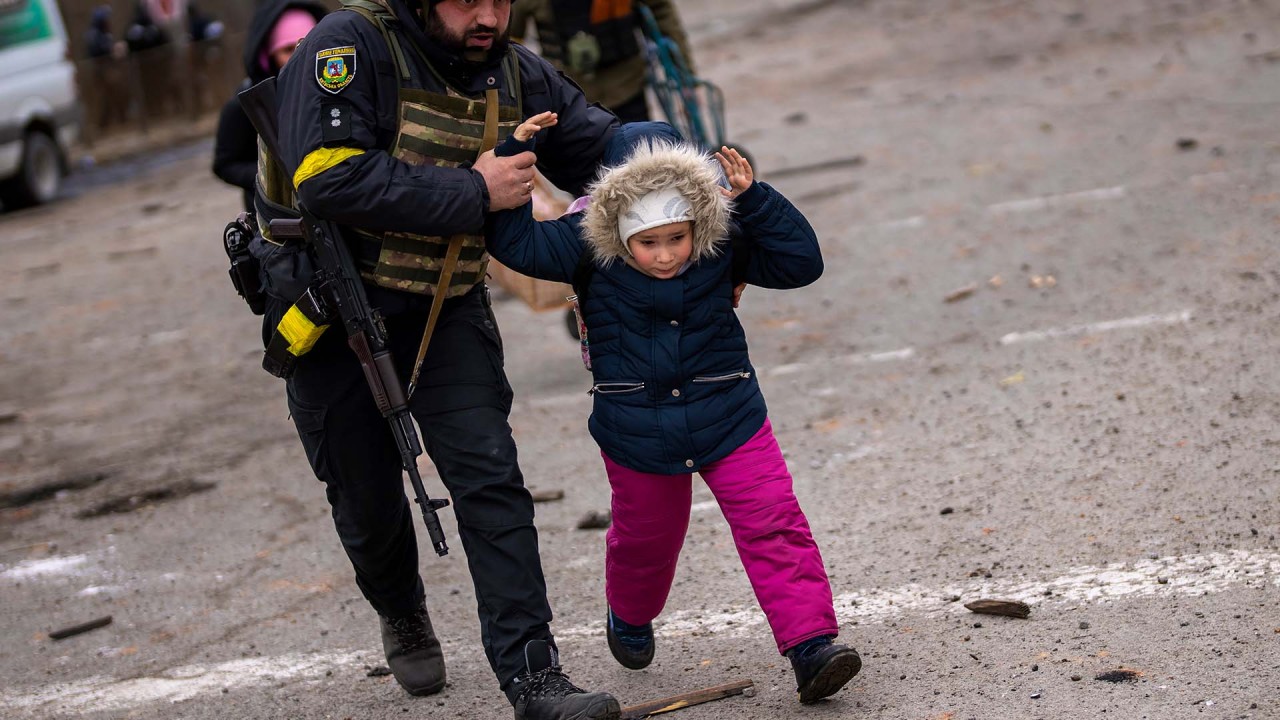
02:35
Civilians in Ukraine caught in escalating attacks despite Russian promises of humanitarian corridors
Explainer | Escaping Ukraine: what are humanitarian corridors?
- Russia opens humanitarian corridors for civilians to flee Ukrainian cities
- In Syria, corridors were created for opposition cities after heavy bombardment
As more Ukrainian towns and cities come under siege, concern is mounting for millions of civilians in the crossfire.
Russia on Tuesday said it opened humanitarian corridors for civilians to flee pummelled Ukrainian cities, though Ukrainian leaders were sceptical since prior efforts to establish evacuation routes crumbled amid renewed attacks.
Russia’s Defence Ministry listed routes from Kyiv and four other Ukrainian cities: Cherhihiv, Sumy, Kharkiv and Mariupol, the Interfax news agency reported.
The defence ministry added that Russian forces in Ukraine had introduced a “silent regime” from 0700 GMT (3pm Hong Kong time), Interfax reported.
Ukrainian President Volodymyr Zelensky accused Russia of reneging on previous escape route agreements and planting explosives on roads.
“There was an agreement on humanitarian corridors. Did that work? Russian tanks worked in its place, Russian Grads (multiple rocket launchers), Russian mines,” Zelensky said in a video posted on Telegram.
Russia’s UN ambassador Vassily Nebenzia said evacuation would be also offered towards Ukrainian cities to the west of Kyiv.
“Ultimately it will be the choice of the people themselves where they want to be evacuated to,” Nebenzia said on Monday.
What are humanitarian corridors?
Humanitarian corridors arise when a population is caught in a war zone, particularly when a city or town is under siege. The idea is that hostilities are halted for a certain time to allow civilians who need to flee to do so along designated routes or to allow urgent humanitarian aid to enter for civilians who remain.
The term was first evoked during the Bosnian War in the 1990s, when the UN set up “safe areas” for civilians. But the attempt was seen as a failure since the UN was unable to protect the zones when they came under attack.
How were they used in Syria?
During the Syrian civil war, the Russian and Syrian militaries pursued a strategy of systematically besieging opposition-held cities, towns and districts, sometimes for months or even years. The sieges rained destruction on the populations, with air strikes, artillery and rockets blasting residential districts, hospitals and infrastructure.
Eventually in each case, the Russians and Syrians would offer humanitarian corridors, telling civilians and even some fighters they could leave. Most would then be funnelled into the northwest province of Idlib, which remains to this day the last opposition-held enclave in Syria.
Humanitarian corridors were created for besieged districts around Damascus and parts of the cities of Homs and Hama. The largest and most famous was for eastern Aleppo in late 2016, capping four years of devastating siege.

Were they safe?
Russian and Syrian forces were often accused of breaking the ceasefires surrounding humanitarian corridors with continued bombing of the besieged cities.
“When they talked about these humanitarian corridors or ceasefires, we never believed them. How can you trust someone to stop who is bombing you all the time?” said Afraa Hashem, a 40-year-old activist who survived the Aleppo siege and now resides in London.
She recalled how during a humanitarian corridor ceasefire on December 14, 2016, the house where she was sheltering with her family was hit by incendiary bombs.
There were also cases of civilians or fighters being detained by Syrian forces as they tried to use humanitarian corridors despite promises of safe passage. In some cases, opposition fighters reportedly opened fire on corridors, either to prevent people from leaving or to spark clashes.
Still, tens of thousands of people used the corridors to get out of the combat zones. They make up the bulk of the 3 million people crowded into Idlib province, which is surrounded by Syrian forces and is still hit by Russian air strikes.
“After four years under bombs, they forced us to leave, that’s what it is” said Hashem. “They didn’t save us. They put us in another area of bombs, Idlib.”
So were the corridors effective?
Ultimately, they were effective in attaining the goals of Russia and the Syrian government: to regain control of opposition areas.
Critics say Russia and Damascus benefited another way as well by carrying out mass demographic change, removing large opposition populations, many of whom have not been able to return to their homes.
Human rights groups and humanitarian agencies point out that under international law, every effort should be made to ensure civilians’ safety no matter where they are.
The tactic of siege-plus-humanitarian corridor, they say, essentially gives residents a brutal choice between fleeing into the arms of their attackers or dying under bombardment.
They said the offer also gives an illusion of legitimacy to the mass slaughter of civilians who remain behind once the siege resumes in full force.
“It is not like Russia can create a humanitarian corridor for two days and then say: ‘Well, we’ve done our job, now we can destroy everything’,” said Sara Kayyali, Syria researcher for Human Rights Watch.
Additional reporting by Agence France-Presse

